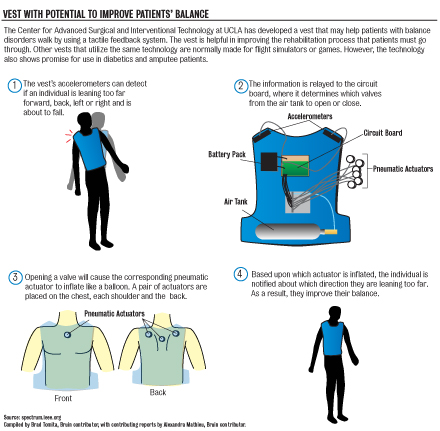Center for Advanced Surgical and Interventional Technology’s Haptic feedback vest may help those who struggle with balance

By Alexandra Mathieu
April 12, 2010 9:18 p.m.
People who live with balance disorders or have had lower-limb amputation soon could benefit from haptic feedback.
Haptic feedback is a process that uses technology to provide patients with information about areas of sensory loss, said Steven Wu, a biomedical engineering graduate student and researcher at the Center for Advanced Surgical and Interventional Technology at UCLA.
The Center has engineered a vest that uses haptic feedback to improve patients’ balance by warning them of their movement before a fall, Wu said.
The vests will soon be tested on patients, said Dr. Eileen Fowler, a physical therapist and director of the Kameron Gait and Motion Analysis Laboratory.
Other patients, such as diabetics who eventually develop nerve damage, could also benefit from haptic feedback research, said Dr. Richard Fan, a biomedical engineering graduate student and researcher at the Center.
The vest consists of parts that inform wearers about the direction and intensity of a potential fall. As a result, wearers can adjust their bodies to avoid a fall. Measurements of movement occur on four axes, including forward, backward, right and left.
Individuals wearing the vest can then alter their position using the information they receive. Accelerometers, which detect the movement, relay the information to a circuit board, which then inflates balloon-like pneumatic actuators that make skin contact.
By inflating at a high frequency, the actuators inform patients about both their movement and its direction. The vest also has auditory feedback from the popping sound of the actuators filling up with air, Lee said.
The vest weighs about five pounds, mainly because of the current size of the battery and electronics, said Michael Lee, a biomedical engineering graduate student and researcher who tested the vest.
With further research, the vest has the potential to be much lighter, Lee said.
Although Lee does not suffer from a balance disorder, his regular balance was improved when he tried on the vest, he added.
Balance involves the work of multiple important sensory systems in our body, which include eyesight, the brain and inner ear and movement in space, Wu said.
“People lose balance because they don’t use one or more of the vital systems that control balances, and lose sensation on nerve, skin, ankles (and other parts of the body),” Wu said.
The vest will require a brief training period depending on adjustments necessary, Wu said.
The training periods will depend on both the intellectual capabilities of the patient and the changes necessary to adjust the vest’s feedback, Fowler said.
The vest will be tested within six months, Wu added.


